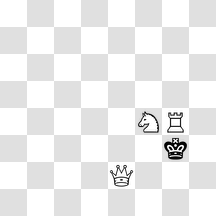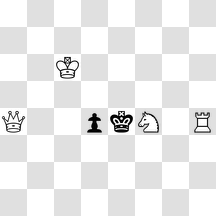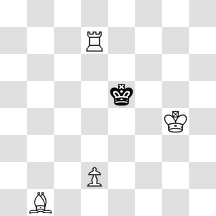The Art of Problem Composition (1878)
I came across this article in St. Louis Global-Democrat (1878-06-02, p. 10). At the time, there was no general source on problem composition in print. Earlier books were only collections of problems, and S. Loyd’s Chess Strategy was published only later the same year.
As no author is mentioned, it was probably written by the column editor. B. R. Foster was the editor from 1877-05-20, according to a notice in the column of that day, the previous editor B. S. Wash retiring as editor due to pressures of work.
I have modified notation from descriptive to short algebraic, but otherwise not changed anything of the text.
The Art of Problem Composition
Many persons have asked us, “How do you compose problems?” and we have invariably answered them in a vague, indefinite sort of way, saying that we compose a problem just as we compose an essay, but, at the same time, fully realizing the difficulty of answering their question. It will be our endeavor, in the following article, to throw out a few suggestions that will enable the reader to intelligently understand and induce him to study the beautiful art. As a general remark we would say that unless one possesses genius, he will fail in the attempt at problem composition, just as one would not succeed in writing poetry unless he could create fancies, for it has been truly said that problems are the poetry of chess; but every one may learn how problems are constructed without having the gift to compose. A man may know how a poet writes poetry without being a poet himself. What will be touched upon in the following essay, we have never seen anywhere in print, and are, therefore, our own pilot exploring an unknown sea, and begging the indulgence of the critical mariners around us.
In the art of problem composition there are two methods, which we will call the inductive and the deductive. By the first, the men are so arranged on the board as to effect a mate, after which they are removed to different squares, and a mate in two, three, four or more moves, produced at the pleasure of the composer. By the second an idea is conceived and built upon a basis, and the men so placed as to accomplish a mate in the required number of moves. According to the former, the men are disposed on the board in a mating combination, and the idea or principle inferred; according to the latter, the idea or principle is assumed, and the men arranged and made to conform to it.

Diagram 1 : Mating Position
To enable the reader to fully comprehend the two methods, we will compose two three-move problems, one according to each, and explain the processes, step by step.
The Inductive Method
The men are so placed on the board (vide diagram) as to effect mate. It is evident from the position that the R must have been at h4 previous to mating; hence we will place it on that square. It is further evident that if the R was at h4, by removing the black K to f3 and the Q to c4, and checking at e2, mate is accomplished in two moves with a check, however, on each move. It is still further observed that by placing a black P at d4, the black K at e4, and the Q at a4, the mate is accomplished in three moves. Now the white K, apparently being of no use, is placed at c6 to prevent second solutions by 1 Q-c6 ch, and 1 Q-e8 ch. We have now constructed the problem with the following solution:

Diagram 2 : Mate in 3
White Black
1. Qc4 Kf3
2. Qe2+ Kg3
3. Rg4#
1. --- Kf5
2. Qe6+ Kg5
3. Rg4#
The Deductive Method
By this method the composer starts with an idea or conception, and builds upon it. Let us say that we will mate with a P moving two squares. This is our theme, and we will construct a problem embodying it. The white P is located say at d2, in order that it may move to d4 on the mating move. It must be protected, and we will protect it by placing a R at d7, the R at the same time guarding the rank and file on which it is situated. As the black K is to be mated by the P, place him in the center of the board at e5 near white’s d4. It is now observed that the black K has five avenues of escape; therefore, place the white K at g4, so that when he moves to g5 on initial move, escape at f6, f5, and f4 is prevented. A B, which is placed at b1, is also needed to shut off escape at e4 as well as force the black K back to e5 on white’s second move. Let us see now whether we can mate.

Diagram 3 : Mate in 3
- Kg5, Ke6; 2. Bf5+, Ke5; 3. d4#
These are the two methods that composers adopt in problem composition. In explaining them, we have not composed the highest order of problems, but given simple ones, in order that the reader may more easily comprehend the two methods. Our preference is for the deductive, and we would recommend it. Sometimes both are made use of by the composer in one and the same problem, for it frequently happens that one method fails, and in resorting to the other it fails also, and the problemist is compelled to combine the two to accomplish his purpose. Although the writer is not an old problemist, yet he believes that he has entered into the merits and beauties and fascination, if not into the immeasurable depths, of the art, and takes the liberty of giving the following general rules, which his experience and observation have taught him are important in the art of problem composition, it being understood, however, that all general rules admit of exceptions.
General Rules Governing Problem Composition
-
Castling should always be avoided; no exception.
-
Capture of a man on the first move of white is not regarded as good unless intricate, beautiful, and numerous variations result from it.
-
The first moving piece of white should not be placed en prise unless there are other pieces attacked, or unless when moved it is placed on a square that is attacked.
-
If a knight or bishop may be used for two pawns, it is sometimes better to make the substitution.
-
Two queens, three bishops, three knights, or three rooks, of one and the same color on the board, at the same time, is considered an imperfection.
-
Duals should be obviated, if possible, without marring the beauty of construction or destroying the main variations. A dual mate when there is but one variation, is a defect. Duals occurring in the main variations should always be avoided.
-
Checking on every move of white is an indication of bad taste unless there is a great sacrifice of pieces, or unless unusual, intricate and beautiful mates arise. It may of necessity, however, be allowed in letter problems and other fantasies.
-
No unnecessary or useless pieces i. e. such as do not prevent duals or second solutions, or that do not prolong the mate for black to the required number of moves should be employed; even in symmetrical and letter problems, it is better to have every piece on duty.
-
Superiority of force for white is a matter of no consequence; the more difficult and beautiful the problem, the better it is.
-
Endeavor to distribute the men over the board as much as possible in order to make the position pretty, many pieces crowded together not being beautiful.
-
The best constructed and highest order of problems are those in which the mate can not be effected in less than the required number of moves, black making any defense he may elect, and each of his moves being followed by a different one for w hite.
-
In general and briefly, every problem should be so constructed that the key move is made to appear as the least plausible one.
In view of the foregoing rules, no young composer should become discouraged. The best rule to adopt at the commencement is to construct quite a number of two and three-move problems with a check on every move. Although many of them will not admit of publication, they will prepare the way for other, higher and better compositions, and teach an excellent lesson in the art. No problemist succeeds at first. Of the first fifty problems he composes, about twenty-five of them are worthless, and never, or should never, get into print.
One word as to the benefit derived from problem composition. Does it improve a chess player? We answer emphatically yes. A player by composing will learn the different and manifold combinations of the pieces and how to accomplish the mate with certain men placed in certain positions, and will also learn with a keen perception the full and complete power of every piece, even the unobtrusive pawn—which undoubtedly increases his power of combination as well as insight into the game. One other word in reference to the comparison between composers and chess players. We hold that every chess player may and can compose problems and, indeed, become a fair composer; for the whole game is a great problem and move by move, it is reduced to one or fewer moves and he needs but to remodel his ending position in order to make a problem out of it. Herr Anderssen, the great chess player of Germany, in his early days composed a problem for beauty of idea and construction remains unsurpassed to this day. It does not so readily follow, however, that every problemist may become a good chess player. The biographies of composers prove that they are only mediocre players. There may be an explanation of this in the fact that they being peculiarly gifted in the art of composing problems, become so infatuated with it that they neglect the game and consequently do not attain to any degree of proficiency in it. But we imagine that it is more logical to say that as they have no taste for the game, consequently they possess no talent. For taste and talent are twin sisters.
And finally, as hundreds and hundreds of problems have been composed and published, the question might arise, Are there any new ideas in the science of problem composition? We answer the query by saying that all the fundamental ideas have been discovered, and that the newness and originality of a problem consist, not in the discovery of new, but in the combination of old ideas. A new invention consists, not in the discovery of new principles, but in combining those already known so as to accomplish different purposes, and on this patents are granted. One composer arranges his ideas in one way, another in another, each displaying his style and originality by the new arrangement of old ideas, and the greater the facility with which he forms new combinations the more numerous will be his compositions.
This is, indeed, a new era in the art of problem composition, and the heavy, bunglesome problems, for example, of Bone are fast passing into oblivion, together with those unnatural sui-mates and wearisome hundred-move direct mates that sometimes appear in the chess columns of the present day, being superseded by problems with beautiful positions, embracing a distinct idea and having a limited number of pieces, and it has been our endeavor to teach the reader how to compose such problems. It is distinctly understood, however, that this essay is not intended to provoke controversy, but merely to instruct the learner, although we are aware that many of the ideas set forth are antagonistic to the views of those who are called professional problemists.